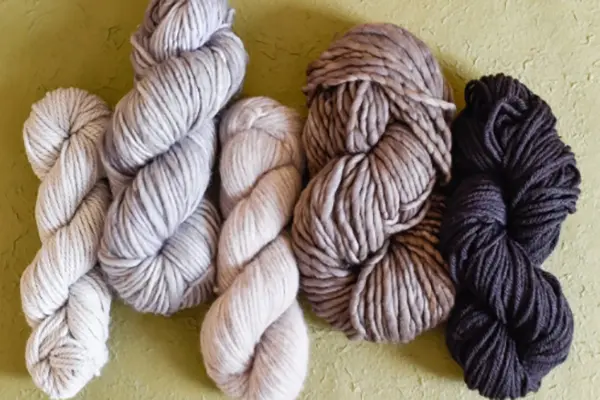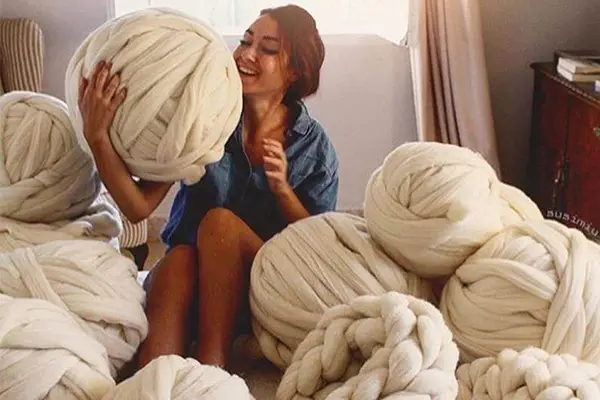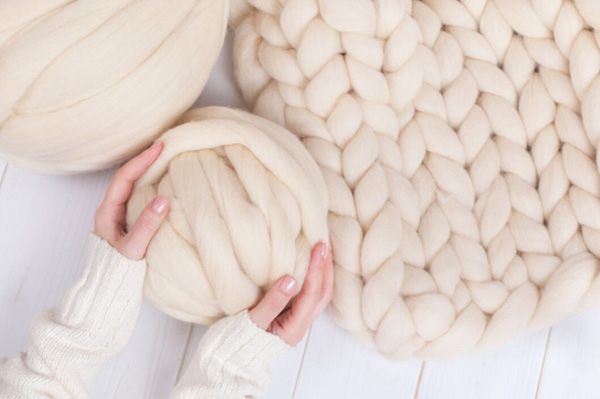Welcome to the wonderful world of yarn! If you’ve ever stepped into a craft store or browsed online for yarn, you know the choices can be overwhelming. From delicate lace-weight threads to super chunky yarn that feels like a cloud, there’s a yarn for every dream project. Understanding yarn weight, especially terms like chunky yarn and super bulky yarn, is key to transforming your creative visions into reality. This guide to yarn is here to unravel the mysteries, helping you confidently select the perfect yarn for your knitting or crochet adventures. Whether you’re a seasoned knitter or just starting, knowing your yarn types will make all the difference. We’ll explore everything from thick yarn to finer strands, ensuring you have the knowledge to choose the right yarn for your project.
What is Yarn and Why is Understanding Yarn Weight So Crucial?
At its heart, yarn is a continuous strand of interlocked fibers, used for knitting, crocheting, weaving, and other textile arts. These fibers can be natural, like wool, cotton, or silk, or synthetic, such as acrylic, polyester, or nylon. As a manufacturer with years of experience, I, Allen, have seen how the quality and type of yarn fundamentally impact the final product. From soft baby blankets to durable fishing nets, the right yarn is paramount. We produce a variety of yarns, including high-quality Polyester Yarn, catering to diverse needs.
Understanding yarn weight is incredibly important. Yarn weight simply refers to the thickness of the yarn strand. It’s not about how much the skein or ball weighs, but rather how thick the yarn itself is. This thickness dictates several key aspects of your project: the size of the needle or hook you’ll use, the final look and feel of the fabric (its drape and texture), and how quickly your project will work up quickly. Using the wrong yarn weight can lead to a project that’s too stiff, too loose, or doesn’t match the pattern’s intended size. For instance, a delicate shawl pattern requiring a fine yarn would turn out completely different if made with a super bulky yarn.
The Craft Yarn Council has established a standard yarn weight system, ranging from 0 (Lace) to 7 (Jumbo). This system helps crafters, designers, and manufacturers like us communicate clearly about yarn properties. Knowing these categories helps you substitute yarns more effectively if a pattern calls for a specific brand or type of yarn you can’t find. It ensures that your project has the best chance of success, resulting in a piece you’re proud of. For many yarn projects, getting the weight of the yarn right is the first step to a beautiful outcome. This yarn weight system is a fantastic tool for every knitter and crocheter.

A Deep Dive into Yarn Thickness: From Lace to Super Bulky Yarn.
The spectrum of yarn thickness is vast, offering endless creative possibilities. Let’s explore the common categories you’ll encounter. At the thinnest end, we have Lace (0) and Super Fine (1, also known as fingering or sock yarn). These fine yarns are perfect for intricate shawls, delicate baby items like socks, and lightweight garments where drape is key. They require small needles and a good deal of patience, but the results are often stunningly detailed. The yarn used for these projects needs to be strong despite its fineness.
Moving up, we find Fine (2, or sport yarn) and Light (3, often called DK or light worsted yarn). DK yarn (which stands for double knit) is a very popular choice, versatile enough for baby clothes, lightweight sweaters, and accessories. Worsted weight yarn (4), sometimes just called worsted, is perhaps the most common yarn weight in North America. It’s a true workhorse yarn, excellent for a wide range of projects including afghans, sweaters, hats and scarves. It strikes a great balance between stitch definition and speed of completion. We often see garment manufacturers requesting this yarn for its versatility and durability.
Then we enter the realm of thicker yarns: Bulky (5, also known as chunky yarn) and Super Bulky (6). These yarns are where speed and coziness really shine. Bulky and chunky yarn options are fantastic for quick knits, warm blankets, and statement winter accessories. Super bulky yarn is even thicker than bulky yarn, creating plush, oversized fabrics in no time. Finally, there’s Jumbo (7), the thickest yarn available, often used for arm knitting or creating dramatic home décor pieces. Understanding the different types of yarn and their thickness opens up a world of creative potential. Each different yarn weight offers unique characteristics for different projects.
Chunky Yarn: Your Go-To for Quick and Cozy Creations?
Yes, chunky yarn (Category 5) is absolutely a fantastic choice when you want to complete a project quickly and achieve a wonderfully cozy result! This type of yarn is ideal for those who love instant gratification. Because of its thickness, projects made with chunky yarn grow incredibly fast on your needles or hook. Think warm blankets, stylish cowls, comfy cardigans, and plush pillow covers. The yarn makes for a substantial fabric that has a lovely weight and warmth, making it perfect for chilly days.
Chunky yarn is often used by both beginner and experienced crafters. For beginners, working with chunky yarn can be very rewarding because you see progress rapidly. The larger stitches are easier to see and manage, which can help build confidence. Experienced knitters and crocheters love chunky yarn for its ability to create bold textures and statement pieces. It’s a versatile material that can be used for garments, accessories, and home décor pieces. Many popular patterns are designed specifically for chunky yarn due to its appealing combination of speed and comfort. This yarn is a favorite for gift-making, as you can whip up a beautiful scarf or hat in just an evening or two.
One of the great things about chunky yarn is the variety of fibers available. You can find chunky yarn made from soft merino wool, easy-care acrylic, breathable cotton, and luxurious alpaca blends. Each fiber will give your chunky knit project a different feel and drape. For example, a wool chunky yarn will be exceptionally warm and is ideal for knitting winter accessories, while a cotton chunky yarn might be better for a breathable throw blanket. Regardless of the fiber content, chunky yarn is sure to add a touch of coziness to your life. The possibilities are endless with this popular yarn weight.

When Should You Reach for Super Bulky Yarn?
You should reach for super bulky yarn (Category 6) when you’re aiming for maximum speed, dramatic texture, and ultimate coziness. This yarn is significantly thicker than chunky yarn, meaning your projects will work up quickly – sometimes in just a few hours! If you have a last-minute gift to make or simply love seeing fast results, super bulky yarn is your best friend. It’s perfect for creating statement pieces like oversized sweaters, incredibly warm blankets, and trendy winter accessories like cowls and hats. The substantial thickness of the yarn creates a fabric with a lot of body and a plush, luxurious feel.
Super bulky yarn is also a fantastic option for certain types of home décor pieces. Think thick, textured rugs, cozy pet beds, or plush floor cushions. The sheer size of the stitches made with super bulky yarn can add texture and visual interest to any room. It’s ideal for projects where you want a bold, modern aesthetic. Furthermore, super bulky yarn is great for beginners who want to learn the basics of knit or crochet without getting bogged down in tiny stitches. The large stitches are easy to see and manipulate, making it less frustrating to learn new techniques.
However, it’s good to know that due to its thickness, super bulky yarn might not be suitable for every pattern. It doesn’t offer much stitch definition for intricate patterns like cables or lace, as the yarn itself is the star of the show. It’s best suited for simple stitches that allow the yarn‘s texture and volume to shine. Also, garments made with super bulky yarn can be quite heavy, so consider this when planning larger projects like a full-length coat. Despite these considerations, the appeal of super bulky yarn for quick, cozy, and impactful yarn projects is undeniable. Its ability to create cozy blankets and warm accessories quickly makes it a favorite among many crafters.
How Do You Choose the Right Yarn for Your Project for Perfect Results?
Choosing the right yarn for your project is perhaps the most critical decision you’ll make before casting on. The first step is to consider the item you’re making. Is it a delicate baby blanket, a sturdy market bag, a flowing scarf, or a warm sweater? The end-use will heavily influence the yarn weight and fiber you should select. For instance, baby items benefit from soft, washable yarns like cotton or specially treated merino, often in a DK or worsted weight. A market bag, on the other hand, needs a strong, durable yarn, perhaps a sturdy cotton or linen, and the yarn weight might vary depending on the desired sturdiness.
Next, consult your pattern. Most patterns will specify a recommended yarn weight (e.g., worsted, chunky yarn, super bulky) and sometimes even a particular brand or type of yarn. While you don’t always have to use the exact yarn suggested, it’s crucial to choose a yarn with a similar yarn weight and to make a gauge swatch to ensure your project turns out the correct size. The pattern will also suggest a needle or hook size, which is a good starting point, but you may need to adjust it based on your tension to match the pattern’s gauge. As a supplier, we, Jinyuent, always emphasize the importance of swatching to our customers like Mark Thompson, who value quality and precision. Understanding the different yarn weight categories is fundamental here.
Finally, consider the fiber content and its properties. Wool is warm and elastic, cotton is breathable and absorbent, acrylic yarn is affordable and easy to care for, and silk adds a beautiful sheen and drape. Each fiber has its pros and cons. Think about who the item is for and how it will be used. Does it need to be machine washable (ease of care)? Is the recipient sensitive to certain fibers? Do you want a lot of stitch definition, or a softer, fuzzier look? For example, our Cotton Yarn is excellent for items needing breathability and softness. Answering these questions will help you narrow down your choices and select the perfect yarn that not only looks good but also performs well for its intended purpose. Making the right yarn for your project choice leads to a more enjoyable crafting experience and a final product you’ll love.

Decoding Yarn Standards: What Are DK, Worsted, and Aran Yarns?
Navigating yarn standards can sometimes feel a bit confusing, especially with terms like DK, Worsted, and Aran. These terms all refer to specific yarn weights, helping crafters understand the thickness of the yarn. DK yarn, which stands for ‘double knitting,’ is a Category 3 Light yarn. It’s finer than worsted weight yarn but thicker than sport weight. DK yarn is incredibly versatile and popular worldwide, especially in the UK and Europe. It’s excellent for garments like sweaters and cardigans, baby items, and accessories, offering a good balance of stitch definition and warmth without being too heavy. Many patterns call for DK yarn because it creates a fabric that drapes well and is comfortable to wear.
Worsted weight yarn (Category 4 Medium) is arguably the most commonly used yarn weight, particularly in the United States. It’s a true all-rounder, suitable for a vast array of yarn projects, from afghans and blankets to sweaters, hats, scarves, and toys. Worsted yarn is thicker than DK yarn and provides good stitch definition, making it great for practicing new techniques or showcasing textured stitches like cables. It knits up relatively quickly and creates a durable, warm fabric. When a pattern simply calls for "worsted," this is the yarn they mean. It’s a reliable choice for both beginners and experienced crafters.
Aran yarn is also a Category 4 Medium yarn, very similar in thickness to worsted weight yarn. Historically, Aran yarn was slightly thicker than American worsted, but nowadays, the terms are often used interchangeably, or Aran might be considered a heavier worsted. It gets its name from the Aran Islands off the coast of Ireland, famous for their traditional cabled sweaters. As such, Aran yarn is ideal for knitting cabled garments and other textured projects that require excellent stitch definition and warmth. It’s a sturdy, cozy yarn perfect for durable outerwear and warm blankets. While similar to worsted, always check your gauge, as a true Aran yarn might knit up slightly bulkier. Understanding these common yarn terms makes pattern reading and yarn substitution much easier.
What are the Ideal Needle Sizes for Super Chunky Yarn Projects?
When you’re ready to dive into a project with super chunky yarn (Category 6, sometimes referred to simply as super bulky yarn), choosing the right needle size is paramount for success and enjoyment. Because super chunky yarn is so thick, you’ll need significantly larger needles than you would for finer yarns. Using needles that are too small will result in a fabric that is stiff, dense, and difficult to work with. Your hands will tire quickly, and the beautiful loft of the yarn will be lost.
Typically, super chunky yarn patterns will recommend knitting needles ranging from 9mm (US size 13) to 15mm (US size 19), or even larger. For crochet, corresponding hook sizes would be M/N-13 (9mm) up to P/Q (15mm) or S. The exact needle or hook size will depend on the specific yarn, the pattern’s gauge requirements, and your personal tension. It’s always, always recommended to knit or crochet a gauge swatch. This little step, which might seem tedious, will tell you if your chosen needle size is producing the correct number of stitches and rows per inch, ensuring your finished item matches the intended dimensions and drape.
Don’t be afraid to experiment if your swatch isn’t matching up. If you have too many stitches per inch, your fabric is too dense, so you should try a larger needle size. If you have too few stitches, your fabric is too loose, and you should go down a needle size. For super chunky yarn, the goal is often a fabric that is plush and lofty, rather than tight. Using appropriately large needles not only achieves the desired fabric but also makes the process of working with chunky yarn much more comfortable and enjoyable. Many yarn labels for super chunky yarn will also provide a recommended needle range, which is a great starting point.
Mastering Thick Yarns: Pro Tips for Knitting and Crochet.
Working with thick yarns, including bulky and super bulky yarn, can be incredibly rewarding, offering quick results and wonderfully cozy textures. However, these thicker yarns do come with their own set of considerations. One key tip is to maintain a relaxed tension. If you knit or crochet too tightly with thick yarn, the fabric can become stiff and inflexible, and it can also strain your hands. Let the yarn do the work and aim for even, slightly looser stitches to allow the yarn‘s volume to shine. This is especially important for yarn projects like blankets or oversized sweaters where a soft drape is desired.
Choosing the right tools is also crucial. As mentioned, larger needles or hooks are essential. Consider using circular needles even for flat projects, as they can better accommodate the weight and bulk of the yarn and the growing fabric, taking some strain off your wrists. For super bulky or jumbo yarn, techniques like arm knitting or hand knitting (using your hands and arms instead of needles) can be fun alternatives for creating items like a chunky blanket or scarf. These methods work up quickly and produce a very dramatic, oversized look.
Finally, pay attention to finishing. Weaving in ends with thick yarn can be a bit more challenging than with finer yarns. Use a large-eyed tapestry needle, and try to split the plies of the yarn when weaving in ends to secure them more effectively and make them less visible. Because the stitches are large, poorly secured ends can easily come undone. For seaming, a mattress stitch usually works well, but you might need to experiment to find what looks neatest with your specific thick yarn. Remember that patterns designed for thick yarn are often simpler in construction to let the yarn‘s texture be the focus. Embracing these tips will make your experience with thick yarn enjoyable and your projects successful. This type of yarn is ideal for making a statement.
Can You Achieve Your Desired Thickness by Combining Different Yarns?
Yes, absolutely! Combining different strands of yarn is a fantastic technique to achieve a custom thickness, create unique color effects, or add interesting textures to your knit or crochet projects. If you have a pattern that calls for a chunky yarn or super bulky yarn but you only have thinner yarns in your stash, holding two or more strands of a finer yarn together as you knit or crochet can effectively create a thicker yarn. For example, holding two strands of worsted weight yarn together will give you a fabric similar to that of a chunky yarn. Holding three strands of worsted might get you closer to a super bulky feel. This is a great way to use up leftover yarn or to achieve a specific desired thickness when the exact yarn weight isn’t readily available.
When combining yarns, it’s important to experiment by making a gauge swatch. The resulting thickness isn’t always an exact science, as different fiber contents and yarn constructions can behave differently when held together. Swatching will help you determine the correct needle or hook size to achieve the fabric you want – whether it’s dense and sturdy or soft and drapey. You can combine yarns of the same color for a subtle marled effect, or use contrasting colors for a bolder, tweed-like appearance. This technique allows for immense creativity and customization in your yarn projects.
Beyond just achieving thickness, combining different types of yarn—like a strand of smooth cotton with a strand of fluffy mohair, or a plain yarn with a novelty yarn that has beads or sequins—can add incredible depth, texture, and visual interest to your work. This approach lets you create a truly one-of-a-kind fabric. For instance, adding a thin strand of metallic yarn to a plainer yarn can give your project a subtle sparkle. The possibilities are endless! Just ensure the care instructions for the combined yarns are compatible. As a manufacturer, we sometimes develop new yarn lines by experimenting with blending different fibers and thicknesses, and this same principle can be applied by individual crafters to great effect. For instance, combining our Polypropylene Yarn with a softer fiber could create interesting effects for specific applications.
Exploring the Extremes: What is Jumbo Yarn and How is it Used?
Jumbo yarn (Category 7) represents the very thickest end of the yarn weight spectrum. This yarn is truly massive, often looking more like soft rope or roving than traditional knitting yarn. It’s significantly much thicker than even super bulky yarn, and working with it is a unique experience. Due to its extreme thickness, traditional knitting needles and crochet hooks are often impractical. Instead, jumbo yarn is frequently used for arm knitting or hand knitting. These techniques utilize your arms or hands as the "needles," allowing you to create huge, dramatic stitches very quickly.
Jumbo yarn is often used for creating statement home décor pieces and accessories that boast a bold, oversized look. Think incredibly plush and cozy blankets, chunky bed runners, round floor cushions, pet beds, and dramatic, sculptural wall hangings. The speed at which these projects complete projects is a major draw; you can often finish a large blanket in just a few hours. The resulting fabric is incredibly soft, cushy, and has a very contemporary, almost rustic aesthetic. It’s perfect for adding a touch of hygge-inspired comfort to a room. This yarn is less about intricate stitch patterns and more about showcasing the sheer volume and texture of the fiber itself.
The most common fibers for jumbo yarn are merino wool (often unspun roving), synthetic fibers designed to mimic wool, or cotton tubes filled with stuffing. Merino jumbo yarn is exceptionally soft but can be delicate and prone to pilling if not handled carefully. Synthetic and cotton tube jumbo yarns offer more durability and sometimes ease of care. When working with jumbo yarn, especially unspun roving, it’s important to handle it gently to prevent felting or breaking. While it might not be the yarn you reach for every day, jumbo yarn offers a fun and impactful way to create unique, cozy items like a pillow or a scarf that are sure to turn heads. The yarn offers a unique tactile experience. This is a yarn can be used for projects where you want quick results.
As we’ve explored, the world of yarn, from the finest threads to super chunky yarn and even jumbo yarn, is diverse and exciting. Understanding yarn weight and how different types of yarn behave is fundamental to the success of your creative endeavors. Whether you’re aiming to knit a delicate lace shawl, a sturdy worsted weight sweater, or a quick and cozy chunky knit blanket, there’s a perfect yarn waiting for you. Remember that every pattern benefits from the right yarn choice.
As Allen from Jinyuent, a manufacturer and supplier deeply immersed in the textile industry, I know that quality yarn is the backbone of beautiful, lasting creations. We take pride in offering a range of yarns and tools, from Yarn Balls perfect for various crafts to specialized items like precise Measuring Ropes for when accuracy matters in larger textile projects or construction. We encourage you to experiment, to feel the different fibers, and to enjoy the process of turning a simple strand of yarn into something wonderful.
Key Takeaways to Remember:
- Yarn Weight Matters: It refers to the thickness of the yarn and influences needle size, drape, and project speed.
- Standard Categories: Familiarize yourself with yarn weight categories (0-7) for easier pattern following and substitution.
- Chunky Yarn (Category 5): Ideal for projects like quick, cozy blankets, scarves, and hats. Great for beginners.
- Super Bulky Yarn (Category 6): Even thicker than bulky yarn, perfect for fast, oversized projects and maximum coziness.
- Swatch, Swatch, Swatch: Always make a gauge swatch to ensure your project matches the pattern’s size and your chosen yarn works as expected.
- Fiber Choice: Consider the fiber content (wool, cotton, acrylic, etc.) for its properties like warmth, breathability, and ease of care.
- Tool Up Correctly: Use appropriately sized knitting needles or crochet hooks for your chosen yarn weight, especially with thicker yarns.
- Combining Yarns: Holding multiple strands of thinner yarn together can create a custom thickness or unique visual effects.
- Jumbo Yarn (Category 7): The thickest yarn, often used for arm knitting or hand knitting dramatic home décor.
- Enjoy the Process: The most important thing is to have fun and let your creativity flow with the wonderful yarn you choose the right yarn for your project. The possibilities are endless when you understand your materials. This guide to yarn aimed to set you on that path.





